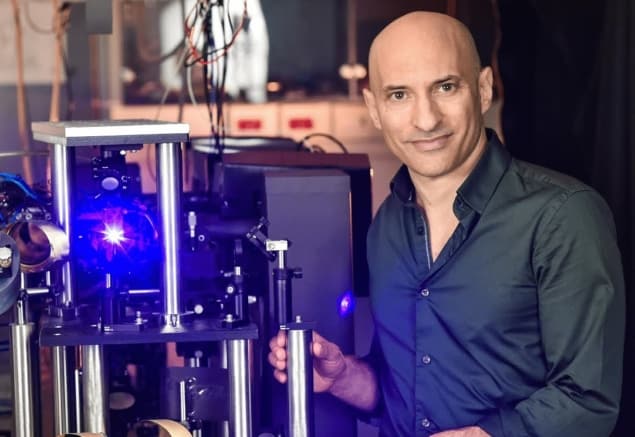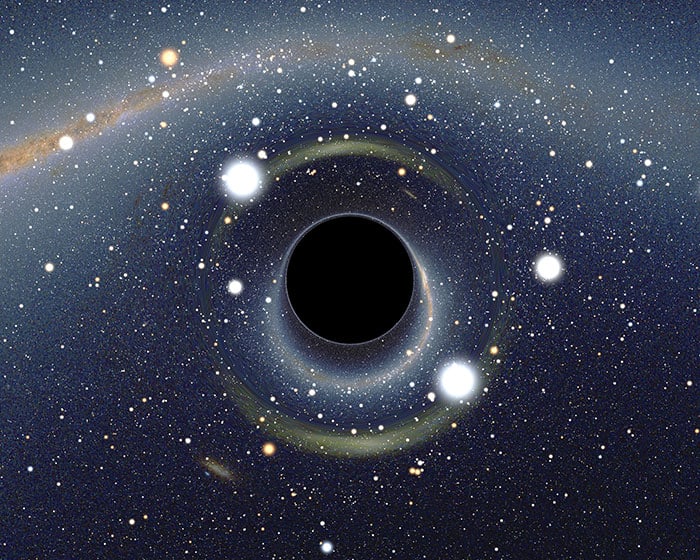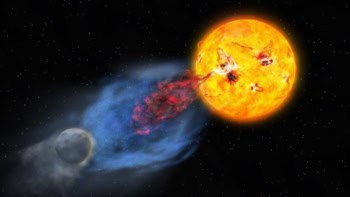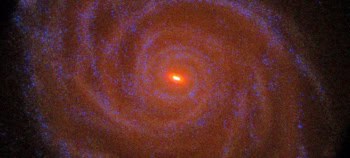
Physicists in Israel have shown that radiation from an analogue black hole has a thermal spectrum. This allows them to assign the “black hole” a temperature, providing indirect experimental evidence for the existence of Hawking radiation.
The popular conception of a black hole is a remorseless cosmic vacuum cleaner that sucks everything in and lets nothing – not even light – escape. When quantum mechanics is added to the mix, however, things get more complicated. In 1974, Stephen Hawking showed theoretically that pairs of photons are created at a black hole’s event horizon – one with positive energy and one with negative energy. The negative energy photon is drawn into the black hole, whereas the positive energy photon is emitted into space. This provides a steady energy flux from the black hole.
The theoretical implications of this are revolutionary, because it suggests that black holes have temperatures. Temperature is defined in statistical mechanics by the average energy in a system that has a large number of degrees of freedom (such as a gas comprising many molecules). In Einstein’s general theory of relativity, however, a black hole is defined purely by its mass, charge and spin. Assigning a black hole a temperature, therefore, requires either giving it additional degrees of freedom or redefining the concept of temperature itself.
Major accomplishment
Detecting Hawking radiation from a black hole would therefore be a major accomplishment – but also a near-impossible task. The problem is that all known black holes have predicted temperatures below the temperature of the cosmic microwave background. This means that any radiation black holes emit would be masked by the radiation they absorb.
One way forward is the fact that the equations governing general relativity are mathematically analogous to those describing wave propagation in moving media. In 1981, William Unruh of the University of British Columbia in Canada showed theoretically that such systems should exhibit Hawking radiation. Several groups have since tried to simulate Hawking radiation using water waves, light in fibre optics and various other systems, but these experiments are fraught with difficulty. Some reported observations of Hawking radiation have later been shown to be erroneous, whereas other claims are still disputed.
For several years, Jeff Steinhauer and colleagues at Technion in Haifa have worked on black-hole analogues that are based on Bose-Einstein condensates – which are ultracold ensembles of trapped atoms. On the high side of a potential-energy step, Steinhauer’s condensate flows slowly. At the low-energy side of the step, however, the flow speeds up. Either side of this “sonic horizon”, pairs of phonons (quanta of sound waves) are created. Above the step, the speed of the sound in the condensate is greater than the speed of the condensate itself, so the phonon escapes. Below the step, however, the sound speed is lower than the condensate’s flow speed. This phonon is therefore swept inexorably into an analogue “black hole”.
Quantum entanglement
In 2014, Steinhauer claimed to have observed self-amplifying Hawking radiation from an analogue black hole with two horizons. Subsequently, in 2016, he detected quantum entanglement between the emitted waves and the waves swept into the black hole. In both these cases, however, there have been sceptics. “His experimental demonstration of a black hole laser was actually something completely different,” says Ulf Leonhardt of the Weizmann Institute of Science, also in Israel, who studies black hole analogues in optical fibres; “And I did a re-analysis of his 2016 paper, concluding what he had seen was a statistical artefact.”
To demonstrate the phenomenon conclusively, Steinhauer’s team made 21 improvements to the experiment over almost three years. As a result, they could measure the energy emitted at each different frequency and show that the radiation had the energy spectrum of a black body, with a well-defined temperature.
Important step
Leonhardt is convinced: “I really congratulate Jeff on his work, which is an important step for the community. It’s something he should be proud of and something we should all celebrate as an excellent paper.”

Physicists stimulate Hawking radiation from optical analogue of a black hole
Theoretical physicist James Anglin of the University of Kaiserslautern in Germany agrees, but he suspects that insight into real black holes will not come from such a clean system as Steinhauer’s. “The truth is that all the important mysteries about quantum effects with black holes are about nonlinear dynamics,” he says. “So what I’d really like to see next would in some ways be a step back from what Jeff has heroically done: to let nonlinear effects in a sonic black hole do some damage, and see just what damage they do.”
Anglin adds that this could help answer important questions about black hole physics such as: “Does emitting thermal radiation make black holes shrink? If so, does the information trapped inside the black hole come back out during shrinking, does the shrinking stop at some remnant quantum object that still holds all the information, or does the information just die? Does the black hole surface area really count as entropy? Is there a deep connection between quantum mechanics, thermodynamics, and gravity?”
The research is described in Nature.



